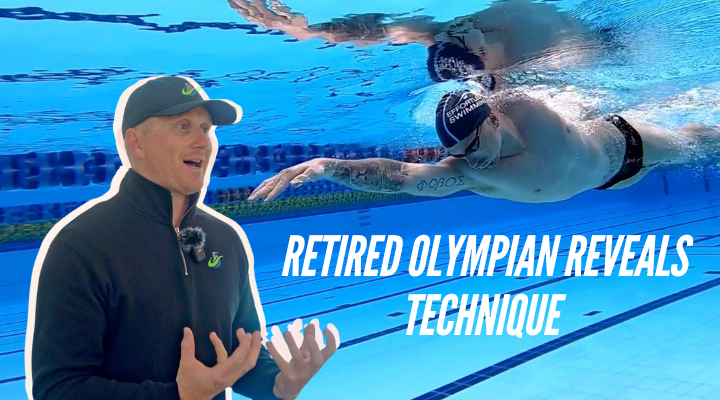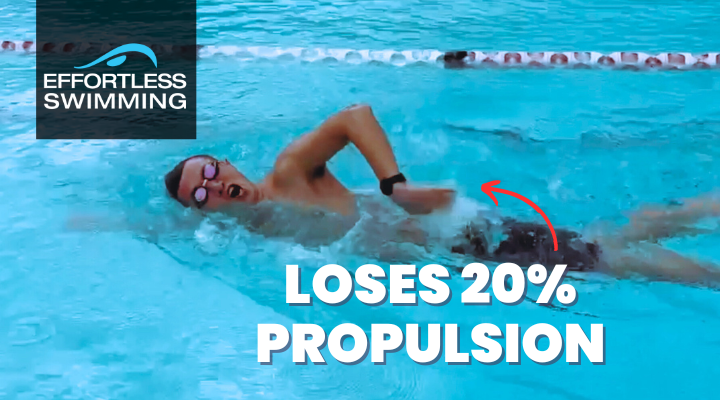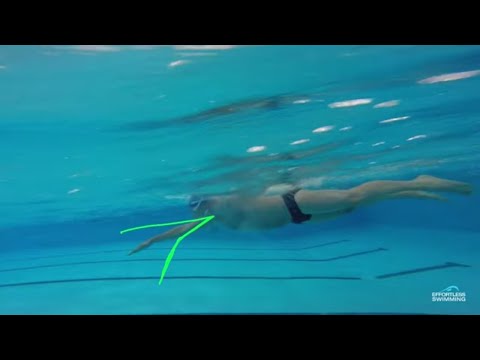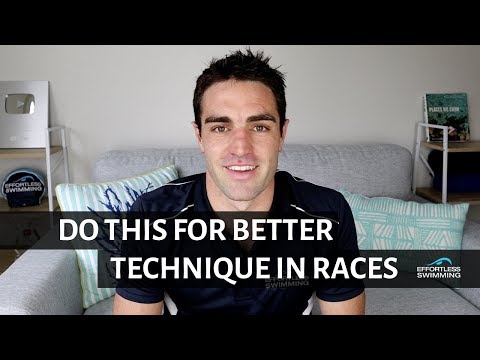Edmund joined our online stroke analysis coaching last year with a goal to swim faster and place better in his open water swims. Over the past 14+ months, he’s gone from being last out of the water to a mid-pack swimmer.
Transcription:
Hey, Brenton here. In today’s video, I want to show you someone who joined us 14 months ago inside our stroke analysis membership and he’s gone from being a back of the pack swimmer, every single race, to now being a middle of the pack swimmer. So I want to show you some of the things that we’ve worked on and developed in the stroke over the last 14 months, and what some of those drills are, or what some of those focus points are, that he used in order to swim faster and really make a dramatic change in his speed and how he feels about his swimming.
There’s still a lot more that we can do in the stroke, but this is where we’re at right now and over the next 12 to 18 months, I think he can certainly still bring that time down quite a bit. So if we look at this front shot here, there’s a couple of things that we initially looked at. Now we started with the real basics. We didn’t go through all these things at once, but I want to talk about the key things that we’ve changed.
The first thing that you might notice is the stroke rate. So the stroke rate was very low. It was around 30 to 35 strokes per minute, which is just not quite high enough to really get much speed and momentum going in the stroke and it doesn’t matter how good a swimmer you are, you’re going to really struggle to get much speed at all if your stroke rate’s that low.
So over the last 14 months, we’ve really worked on developing or increasing the stroke rate to be able to comfortably hold around 60 to 65 strokes per minute in those longer races. It’s becoming a lot easier but when he first started increasing his stroke rate, he said that he couldn’t do more than two laps at that 60 stroke rate. So it did take a while to develop it, but it’s something that we worked on.
Now how did we go about it? A couple of ways. The first one was we did use a tempo trainer, just to be able to get him to match up with that tempo trainer and get a sense of it. He followed some of the sets inside the video membership that we’ve got there but one of the other things he did, and I really like to do this with a lot of swimmers, is that I got him to put a pull buoy in and just put the tempo trainer in and that’s a really good way to get the stroke rate up, because it takes the legs out of it, it takes the balance out of it, and all you can focus on, or all you need to focus on is just getting those arms turning over.
So if you really struggle getting your rating up, you might consider putting a pull buoy in, get your tempo trainer and just match that stroke rate that we want, because that’s going to be much easier to get used to a 60 to 65 stroke rate compared to if you’re trying to do it without a pull buoy in. So that was one of the ways that we did it.
The other thing that you’ll notice here is the alignment. So he was entering very wide. You’ll see that this right hand enters here, 15, 20 centimeters wide of the shoulder. So that as he was extending forwards, the arm would get roughly in line with the shoulder there, but it was starting a bit too wide.
So it’s a lot of resistance, a lot of drag that gets created through the upper arm here as you are reaching forward. Now it’s good to feel balanced and good to feel controlled in it and a wider entering extension will do that. But there’s a point where, if you do go too wide, it is only going to just slow you down. I’ve actually been working on this with another in the membership, who has really … Well, he said he dropped two seconds with the combination of this, changing entry, and another drill that we worked on, but getting that alignment to enter in line with the shoulders, extend straight forward, we call that swimming on train tracks, that is a really good way to minimize the drag. So we worked on that.
We worked on that using a couple of drills. The first one was just that really basic front kick drill that we like to do at clinics and I give to a lot of people when they’re starting out, which can just give you the sense and awareness around what the arms will feel like when they’re in the right position there. The other thing we worked on was the hands out in front, so you’ll see that this left hand was entering really close to the head, just in front of the head there and going quite deep. I mean, what’s that? 30, 40 centimeters deeper than the shoulder. So again, from a drag perspective that was only slowing him down. What we want to do is get the fingers below the wrist, risk below the elbow, basically having that arm straight out in front in order to start the catch because then he’s got an extra 30 to 40 centimeters to give himself time to set up the catch and it’s also just going to minimize that drag.
So we worked on that again with that front kick drill and we’re also doing some drills like the sidekick drill and the 616 drill just to help develop that exact same thing. Now on the right-hand side, the entry was better, it was out in front of the head reaching forwards there, which was good. But you’ll see here there was quite a bit of drift up going on right there. Again, from a drag perspective slowing you down and it makes it quite hard to set up the catch when the fingertips are the highest part of the arm. So we’re able to work on those two things just by using those really simple drills of front kick, sidekick, and those 616 drills. All the drills that we do in clinics and a lot of the time I will give to swimmers when they join us inside the stroke analysis membership.
The other thing you’ll see here, which was part of the reason why his stroke rate was so low, not the whole reason but part of the reason, was his rotation. So you’ll see that the hips here rotating pretty much all the way onto the side to 90 degrees. Now what we generally want to try and do here, we talk about 45 degrees rotation, give or take, five to 10 degrees either way. Now, by going so far on the side we were seeing the legs really coming apart and splaying quite a lot. So looking from the front, it’s quite a good angle here to see. You’ll just see how wide apart the knees are here, how wide apart the kick is and just how far the hips were getting on the side.
So while you definitely need to rotate, you really want a lot of that drive and that initiation of the rotation that comes from the hips. If you go too far, you tend to lose balance and we were sort of seeing this here. So one of the other things we had to work on was just bringing that back down a little bit. So you can see from … Probably see it better here.
So you can see with that rotation now that he’s brought it back down to about … Good. Yeah, much better. So it’s a little bit more on one side, which is here and then on the other side it gets down to about 30 degrees. So that’s much better and we talk about it being okay to have an uneven stroke, as in you can rotate more to one side than the other. We sort of seeing this here, so more on that breathing side, a bit less on the other. So it’s that better control through the hips that will help you increase the stroke rate and do a number of other things as well. So we looked at that.
Now we talked about the knees and the inner thighs really being too far apart as well as the feet. So in order to reduce the drag, we had to minimize the size of the kick and minimize the splay of the legs and just basically bring the inner thighs and the knees a bit closer together. So while they will certainly kick apart and move apart, we want this gap to not be really, really wide because you tend to lose a lot of the tautness and control through the core in the midsection that way.
So a drill that we did there was, we got the kickboard put it between the legs, like a pull boy and the reason that we use a kickboard with that, and I credit Miguel Lopez in Thanyapura in Thailand, I got this drill from him, because the kickboard is so narrow, you’ve got to keep a little bit of engagement through your core and through your inner thighs here to keep it between your legs, whereas a pull buoy’s generally a bit wider. So with that Kickboard between the legs, teaches you the right sort of engagement through that midsection. So that was one thing that certainly helped him bring the legs closer together and tighten up that kick.
The other thing that we worked on there as well as the overall posture of drawing your belly button into your spine, squeezing your bum cheeks together a little bit and straightening out through the hips as opposed to having no engagement through that midsection and just having this big bend through the hips. So that was another focus point that we worked on over the last 14 months there. So they were the key ones.
Now the other thing that we looked at here was the exit. So it was quite a short exit on some of the strokes and it was a very deep pull, especially at this backend. We saw this scooping motion coming up here, where you can really see from his back half, the hand is coming up, coming up towards the hip, then it slides in towards the body. So that last, almost third, of the stroke wasn’t getting much from it at all. So we had to do a little bit of this tricep extension drill that you might’ve seen in some other videos just to get it to exit further back past the hip and just maintain that hold of the water longer throughout the stroke. So, especially see it on that left side and then the right side, you can see that difference there now that palm’s facing back behind him, compared to when it was at the front here, pretty much the whole time just scooping upwards there.
So with that tricep extension drill, the focus was can you get the elbow just out of the water? Can you keep that palm facing back behind you for longer and not come from quite as deep? So I think that for the majority of the strokes, he’s pretty much doing that now and I think that’s a big contributor to increasing the distance per stroke and maintaining that speed throughout the stroke as well. So we worked on that quite a bit and it took him about three or four weeks to really make that a pretty solid habit and be able to do it quite comfortably without needing to think about it too much.
Now one of the other things that we looked at was with the catch. So you’ll see with the catch here that as he was going through it, he was actually getting the fingers to point down quite well and actually getting a high elbow catch. So that position there is actually quite good. What you will notice though with the depth of the hand is that there was such a pause out in front that it was this real stop-start sort of stroke. So big pause there, big pause there, so a lot of the momentum was lost. Then you’ll notice that one of the big differences here when we look from the side, is that there’s a much better flow through the strike.
So see, just keeps it moving through a lot better. So there might still be a little bit too much of a pause there. We can probably reduce it a bit, but overall, so much better. Yeah much, much better there, so there’s a very little pause. Now the other thing too, you’ll notice the body position. So the body position, we can still certainly bring it up, but through a lot of these videos, you’ll just see that the legs and the hips were dropping down a lot there.
So started to really bring it up, it’s a combination of how fast the stroke rate, moving better through the catch and the pull and having less of a pause. So we can still bring that up but that’s coming with time. Some of that comes down to mobility, some of that comes down to the strength and the control through the core but there is an opportunity there to still just reduce the times a bit for those swims where he doesn’t have a wetsuit, but it has improved a lot there.
So they’re really some of the key things that we’ve worked on and we’re also looking at just playing around with the kick. So in this video here, we’re now working on adding in a bit of a two beat kick to the stroke, which you can see here. So we’ve just started to work on this two beat kick for a couple of reasons. So, it’s good to be able to have these different gears when you swim, which means can you do a two beat, four beat, six beat kick? They’re really good ways to be able to play around with your speed and conserve energy at different paces. What we see with some of those really top swimmers is a two or four beat kick at quite a quick pace. You can really sustain that sort of kick for very little effort compared to maintaining a six feet kick.
Now obviously it depends on what events you’re doing. If you’re training for open water, you’re doing a triathlon, it is really good to be able to do a two or four beat kick and check out one of our videos that I’ll link to below if you don’t know what I’m talking about there. I’ve talked a bit about the two, four and six beat kick, but a two and four beat kick can be very good at conserving energy.
The other thing I like about some of this is you can get really good at connecting your catch. So this part of the stroke to your downwards kick on that same side. So through there you’ll see the right catch, right leg kick is going together and that’s something that we want. That’s really the connection and the time that you need in a stroke to have everything sync up and work together.
With the two beat kick you’ll often find that if you can get it in that two beat kick, it’s easier to get it through some of the other types of kick there. So now just sort of playing around with a few of those things while continuing to refine some of these aspects of the stroke and also the catch position and so on but he’s come a long way from back of the pack to mid pack swimmer now and so we’d want to be starting to edge towards that top 25% to 30% over the next six to 18 months. Everyone’s different, everyone progresses at different times but what this swimmer has done here really well, he’s being consistent with sending videos.
So roughly every four to six weeks, he sent in videos and sometimes he’s been able to make the change straight away. Sometimes we’ve had to go, “All right, hang on a minute, we might need to take a different approach.” So no matter which approach you take, it’s just that consistency, getting in the water regularly, I like to say at least three times a week and just continuing to check in with your stroke because what you think you are doing can be very different than what you’re actually doing. So I like to be able to just check in with each of those things and don’t be dismayed if you find that you … you might plateau for a little while, or you haven’t been able to make those changes in the stroke. Oftentimes you just need to overdo the thing that you’re trying to achieve there.
It’s something that I see all the time when people send in their videos in the stroke analysis membership, is that sometimes we’ll just need to go, “All right, hang on a minute, let’s just really exaggerate, really overdo the thing that we’re trying to achieve here.” If you go too far, we can take a step back and reduce it a bit, but you are more than likely going to have to make it feel very strange and awkward at first but that will become your new normal soon enough. So that’s often the approach we have to take, but that’s why it’s good to have a coach or someone that you trust to look at your stroke that way. So thanks for watching. Let me know if you have any questions below on what some of the drills might’ve been or some of the other things that we worked on, and let me know what you’re working on in your stroked below. Keep it simple, one or two things is all that you need and thanks again for watching. Make sure you like and subscribe if you’re not already.









